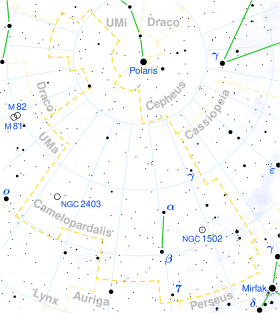Beta Camelopardalis

| |
| Observation data Epoch J2000 Equinox J2000 | |
|---|---|
| Constellation | Camelopardalis |
| Right ascension | 05h 03m 25.08963s[1] |
| Declination | +60° 26′ 32.0895″[1] |
| Apparent magnitude (V) | 4.02[2] |
| Characteristics | |
| Spectral type | G1Ib–IIa[3] |
| U−B color index | +0.62[2] |
| B−V color index | +0.93[2] |
| R−I color index | +0.49[2] |
| Astrometry | |
| Radial velocity (Rv) | −190[4] km/s |
| Proper motion (μ) | RA: −6.50[1] mas/yr Dec.: −14.15[1] mas/yr |
| Parallax (π) | 3.74 ± 0.21[1] mas |
| Distance | 870 ± 50 ly (270 ± 20 pc) |
| Absolute magnitude (MV) | −3.1[5] |
| Details | |
| Mass | 6.5[3] M☉ |
| Luminosity | 1,592[6] L☉ |
| Surface gravity (log g) | 1.79[3] cgs |
| Temperature | 5,300[3] K |
| Metallicity [Fe/H] | −0.06[7] dex |
| Rotational velocity (v sin i) | 11.7[8] km/s |
| Age | 63[3] Myr |
| Other designations | |
| Database references | |
| SIMBAD | data |
| Data sources: | |
| Hipparcos Catalogue, CCDM (2002), Bright Star Catalogue (5th rev. ed.) | |
Beta Camelopardalis (β Cam / β Camelopardalis) is a star in the constellation Camelopardalis. It is a yellow G-type supergiant with an apparent magnitude of +4.03, approximately 870 light years from Earth.
β Cam has two close companions: a 7th magnitude A5 star at 84"; and a 12th magnitude star at 15".[9]
References
- 1 2 3 4 5 Van Leeuwen, F. (2007). "Validation of the new Hipparcos reduction". Astronomy and Astrophysics. 474 (2): 653. arXiv:0708.1752
 . Bibcode:2007A&A...474..653V. doi:10.1051/0004-6361:20078357.
. Bibcode:2007A&A...474..653V. doi:10.1051/0004-6361:20078357. - 1 2 3 4 Ducati, J. R. (2002). "VizieR Online Data Catalog: Catalogue of Stellar Photometry in Johnson's 11-color system". CDS/ADC Collection of Electronic Catalogues. 2237. Bibcode:2002yCat.2237....0D.
- 1 2 3 4 5 Lyubimkov, Leonid S.; Lambert, David L.; Korotin, Sergey A.; Rachkovskaya, Tamara M.; Poklad, Dmitry B. (2015). "Carbon abundance and the N/C ratio in atmospheres of A-, F- and G-type supergiants and bright giants". Monthly Notices of the Royal Astronomical Society. 446 (4): 3447. arXiv:1411.2722
 . Bibcode:2015MNRAS.446.3447L. doi:10.1093/mnras/stu2299.
. Bibcode:2015MNRAS.446.3447L. doi:10.1093/mnras/stu2299. - ↑ Gontcharov, G. A. (2006). "Pulkovo Compilation of Radial Velocities for 35 495 Hipparcos stars in a common system". Astronomy Letters. 32 (11): 759. Bibcode:2006AstL...32..759G. doi:10.1134/S1063773706110065.
- ↑ Gray, David F.; Pugh, Teznie (2012). "The Third Signature of Granulation in Bright-giant and Supergiant Stars". The Astronomical Journal. 143 (4): 92. Bibcode:2012AJ....143...92G. doi:10.1088/0004-6256/143/4/92.
- ↑ McDonald, I.; Zijlstra, A. A.; Boyer, M. L. (2012). "Fundamental parameters and infrared excesses of Hipparcos stars". Monthly Notices of the Royal Astronomical Society. 427: 343. arXiv:1208.2037
 . Bibcode:2012MNRAS.427..343M. doi:10.1111/j.1365-2966.2012.21873.x.
. Bibcode:2012MNRAS.427..343M. doi:10.1111/j.1365-2966.2012.21873.x. - ↑ Kovtyukh, V. V.; Gorlova, N. I.; Belik, S. I. (2012). "Accurate luminosities from the oxygen λ7771-4 Å triplet and the fundamental parameters of F-G supergiants". Monthly Notices of the Royal Astronomical Society. 423 (4): 3268. arXiv:1204.4115
 . Bibcode:2012MNRAS.423.3268K. doi:10.1111/j.1365-2966.2012.21117.x.
. Bibcode:2012MNRAS.423.3268K. doi:10.1111/j.1365-2966.2012.21117.x. - ↑ Rodrigues Da Silva, R.; Canto Martins, B. L.; De Medeiros, J. R. (2015). "On the Nature of Rapidly Rotating Single Evolved Stars". The Astrophysical Journal. 801: 54. arXiv:1503.03447
 . Bibcode:2015ApJ...801...54R. doi:10.1088/0004-637X/801/1/54.
. Bibcode:2015ApJ...801...54R. doi:10.1088/0004-637X/801/1/54. - ↑ Mason, Brian D.; Wycoff, Gary L.; Hartkopf, William I.; Douglass, Geoffrey G.; Worley, Charles E. (2001). "The 2001 US Naval Observatory Double Star CD-ROM. I. The Washington Double Star Catalog". The Astronomical Journal. 122 (6): 3466. Bibcode:2001AJ....122.3466M. doi:10.1086/323920.
External links
This article is issued from Wikipedia - version of the 7/28/2016. The text is available under the Creative Commons Attribution/Share Alike but additional terms may apply for the media files.